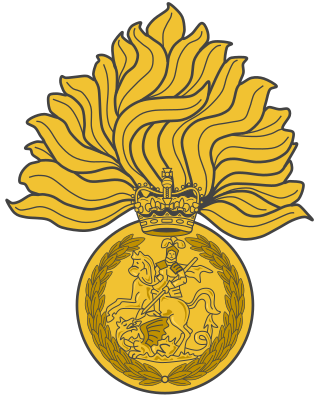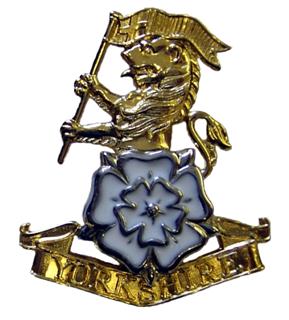
The Royal Regiment of Fusiliers is an infantry regiment of the British Army, part of the Queen's Division. Currently, the regiment has two battalions: the 1st battalion, part of the Regular Army, is an armoured infantry battalion based in Tidworth, Wiltshire, and the 5th battalion, part of the Army Reserve, recruits in the traditional fusilier recruiting areas across England. The Royal Regiment of Fusiliers was largely unaffected by the infantry reforms that were announced in December 2004, but under the Army 2020 reduction in the size of the Army, its second battalion was merged into the first in 2014.

The Royal Gloucestershire, Berkshire and Wiltshire Regiment was a short-lived infantry regiment of the British Army.

The Light Infantry was an infantry regiment of the British Army, part of the Light Division. The regiment was one of four 'large' regiments formed after the 1966 Defence White Paper through the amalgamation of units of the Light Infantry Brigade. Originally consisting of four battalions, it was later reduced to three battalions, and finally amalgamated into The Rifles with just two battalions which became the 5th and 3rd Battalions respectively.
The Rifle Volunteers was a regiment of the British Territorial Army. In 2007, it was re-designated as 6th Battalion, The Rifles.
The East and West Riding Regiment was a regiment of the British Territorial Army from 1999 to 2006. In 2006, it was re-designated as the 4th Battalion The Yorkshire Regiment.

The Royal Yorkshire Regiment is an infantry regiment of the British Army, created by the amalgamation of three historic regiments in 2006. It lost one battalion as part of the Army 2020 defence review. The regiment's recruitment area covers the ceremonial counties of the East Riding of Yorkshire, North Yorkshire, South Yorkshire and West Yorkshire; areas near Barnsley are recruitment area for the Rifles.
The Rifles is an infantry regiment of the British Army. Formed in 2007, it consists of four Regular battalions and three Reserve battalions, plus a number of companies in other Army Reserve battalions. Each battalion of The Rifles was formerly an individual battalion of one of the two large regiments of the Light Division. Since formation the regiment has been involved in combat operations, first in the later stages of the Iraq War and in the War in Afghanistan.

The 52nd Lowland Volunteers is a battalion in the British Army's Army Reserve or reserve force in the Scottish Lowlands, forming the 6th Battalion of the Royal Regiment of Scotland, also known as 6 SCOTS. Due to its erstwhile association with the 1st Regiment of Foot, it is the senior Reserve line infantry battalion in the British Army. It is one of two Reserve battalions in the Royal Regiment of Scotland, along with 51st Highland, a similar unit located in the Scottish Highlands.
The Royal Welsh Regiment was an infantry regiment of the Territorial Army in the United Kingdom. It existed from 1999, until it was re-designated as the 3rd Battalion, The Royal Welsh in 2006.

The Royal Northumberland Fusiliers was an infantry regiment of the British Army. Raised in 1674 as one of three 'English' units in the Dutch Anglo-Scots Brigade, it accompanied William III to England in the November 1688 Glorious Revolution and became part of the English establishment in 1689.

The Glasgow Highlanders was a former infantry regiment of the British Army, part of the Territorial Force, later renamed the Territorial Army. The regiment eventually became a Volunteer Battalion of the Highland Light Infantry in 1881. The regiment saw active service in both World War I and World War II. In 1959 the Highland Light Infantry was amalgamated with the Royal Scots Fusiliers to form the Royal Highland Fusiliers. The Glasgow Highlanders was later amalgamated into the 52nd Lowland Volunteers in 1967.

The 4th Battalion, Parachute Regiment, is an Army Reserve unit of the British Army. Now recruiting across the United Kingdom originally the Battalion covered the North of England, with its headquarters located in Pudsey, West Yorkshire. Following the Options for Change review in 1993, 4 PARA amalgamated with the 15th (Scottish) Battalion of the Parachute Regiment, which was downsized and became 15 (Scottish) Company of 4 PARA. As part of further changes in 1999, the Battalion also merged with the 10th (Volunteer) Battalion which then became 10 (London) Company.

The Home Service Force (HSF) was a Home Guard type force established in the United Kingdom in 1982. Each HSF unit was placed with either a Regular Army or Territorial Army regiment or battalion for administrative purposes and given that formation’s title, cap badge and recruited from volunteers aged 18–60 with previous British forces experience. It was introduced to guard key points and installations likely to be the target of enemy special forces and saboteurs, so releasing other units for mobile defence roles. It was stood down in 1992.
The Tyne Electrical Engineers (TEE) is a Volunteer unit of the British Army that has existed under various titles since 1860. It has been the parent unit for a large number of units fulfilling specialist coastal and air defence roles in the Royal Engineers (RE) and Royal Artillery (RA), many seeing service during both World Wars. TEE companies currently form part of the RE and of the Royal Electrical and Mechanical Engineers in the Army Reserve.
The Northern Cyclist Battalion was a bicycle infantry battalion of the Territorial Force, part of the British Army. Formed in 1908, it served in the United Kingdom throughout the First World War and in 1920 it was converted as part of the Royal Garrison Artillery.

Dare Wilson Barracks, is a military installation in Hexham, Northumberland. The building is named after Major General Dare Wilson who was commissioned into the Royal Northumberland Fusiliers and commanded 22 Special Air Service Regiment in the early 1960s.

The London Guards is an administrative formation within the British Army comprising the Army Reserve companies of the British Army's Grenadier, Coldstream, Scots and Irish Guards. On formation these companies drew their personnel from the London Regiment which existed from 1993 to 2022.
The 7th Battalion, The Rifles is an Army Reserve battalion of the British Army originally formed in 1999 as an independent regiment, however later became part of The Rifles following the Future Army Structure programme, and remains an integral part of the regiment.
The Northumbrian Volunteers was a short-lived Territorial Army infantry regiment of the British Army, in existence from 1971 to 1975.










